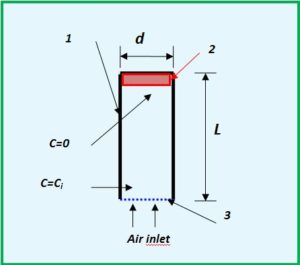reEvolution
Envint srl
PASSIVE SAMPLING MONITORING OF AIR POLLUTION
Passive sampling in air quality assessment
Measurements of air quality (measurements of pollutants concentrations) may be carried out with automatic instrumentation in which a sensor turns the concentration of a pollutant into an electric signal. This signal is then properly send to a data acquisition system for transmission to a central station. Unfortunately, such automatic techniques are limited to just a few pollutants since sensors are available for few chemical species. In ad
dition, they are very expensive either in terms of investment and maintenance. For those pollutants that cannot be evaluated by automatic instruments, accumulation methods are used. They are based on sampling a volume of air over a suitable substrate (Filters, traps, etc.) in which the relevant chemical species are irreversibly collected. After sampling, the substrates are analysed by using a variety of analytical methods and the pollutant concentrations is calculated according to the volume of air which has been sampled. This type of sampling can be defined as “active” in that air is forced through the absorbing substrates.
An alternative sampling method is the “Passive” one. In this type of sampling, a physical principle related to molecular diffusion of molecules in gas phase is applied. In “passive” sampler, pollutants dispersed in atmosphere are irreversibly adsorbed on suitable adsorbing surfaces. On this surface, a concentration gradient is developed. According to the physical nature of molecular diffusion, such a concentration gradient induces additional transport of pollutants from the air to the surface. This, in turn, causes an apparent flow rate of air which is equivalent to that defined in active samplers. Therefore, after a suitable time, the substrate accumulates an amount of pollutants which can be analysed by proper analytical methods. The apparent airflow is defined by the Fick law.
The following figure 1 shows the scheme of a “passive sampler” (Axial type sampler). It is usually made of a cylindrical body (1) having length L and diameter d. The materials used can be glass, plastic, metals and so on according to the type of pollutants and the according to the following analytical method used for analysis. Pollutants molecules, coming from the bottom, diffuse upward to the substrate (2) where they are irreversibly adsorbed. Along the axis of the passive sampler body, a concentration gradient is developed. Such gradient is controlled by the concentration of pollutant Ci and the concentration developed near the surface of the absorber. Since the latter is almost zero, , the sampling velocity is mainly caused by the value of concentration Ci. In addition to concentration gradient, the amount of pollutant adsorbed by the substrate is determined by the geometry of passive sampler (mainly L and d) and other parameters such as the diffusion coefficient in air of the pollutants, the ambient temperature and others. The screen mesh (3) is used to break down turbulences so that a linear flow rate is ensured in the passive sampler body. This is a prerequisite for the validity of the Fick law.
Figure 1 – Schematic of a Passive Sampler
After exposure of the passive sampler to air for a suitable time, varying from a few hours to several weeks, the sampler (actually the substrate) is brought to laboratory for analysis. By knowing the apparent diffusion flow rate, is then possible to calculate the pollutants concentration. In conclusion, the passive sampling method is simple and flexible. These are the main reason why it is used worldwide in a vast variety of air quality assessment requirements.
Next Figure 2 shows the basic principle of monitoring air pollution through a passive sampler. Phase (A) show a closed (capped) passive sampler which is, in this case, isolated from the surrounding air. When the cap is removed (B) than pollutant molecules (in green) enter the passive sampler, through the screen mesh, and react with the adsorbing substrate (in red) where they are irreversibly absorbed.
After sampling the passive sampler is capped again (C) to avoid possible contaminations and then brought to a chemical laboratory for analysis. The content of adsorbed molecules are then converted in pollutant concertation by using appropriate mathematical formulas which take, as said before, into account for the diffusion coefficient of the pollutant molecules, temperature, geometry of the passive sampler.
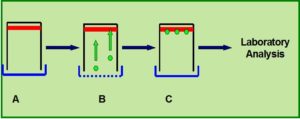
Figure 2 – Scheme of operation for a passive sampling of atmospheric pollution
Unfortunately, passive sampling, so useful in the assessment of air pollution by gas-phase components, cannot be adapted to the evaluation of particulate matter since the diffusion coefficient of airborne particulate matter is several order of magnitude lower than that gas pollutants. This is the reason why passive samplers are exclusively used for gas-phase molecules.
ANALYST® Passive Samplers
This type of passive sampler was developed at Italian National Research Council (Institute for Atmospheric Pollution). ANALYST® was, patented and certified with the main objective to collects pollutants over a very long time span, allowing unsurpassed sensitivity and reliability. The sampler are small in size and suitable for most applications in ambient air as well as in indoor pollution.
The design of this passive sampler is very flexible. For instance the passive sampler at upper left corner, designated as SO2, has the same basic structure of passive samplers intended for the analysis of aromatic hydrocarbons (Benzene, Toluene, Xylenes and Ethyl-Benzene).
This design allows the development of specially designed devices in which internal chemical reactions may occur (Passive sampler for NO and NOx). In addition, flexibility also extend to the material. According to application, it can be glass, plastic, metals. Figures below show ANALYST® modified from the basic design intended for the analysis of air pollutants.
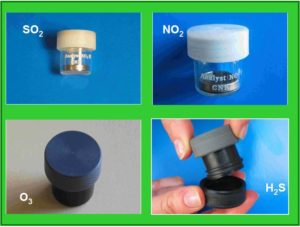
Figure 3– Different models of ANALYST® Passive Samplers
Furthermore, ANALYST® have been tested according to internal consistency. In such tests the concentration measured by a passive sampler exposed for a long period of time was compared with the sum of individual concentrations measured during overlapping shorter periods of time. In this way, it was possible to demonstrate the stability of chemical species formed during exposition, as well as the absence of any saturation effects.
According to this features, ANALYST® was demonstrated to be very useful and reliable for a series of activities and investigations. Among these, applications in ambient atmosphere include:
- Preliminary assessment of air pollution
- Air pollution assessment and air quality measurement
- Historical record of pollution in selected sites
- Classification of monitoring sites
- Spatial mapping of atmospheric pollution
- Spatial integration of data from conventional stations
Applications in indoor environment were also very useful since they include:
- Pollution levels in houses
- Measurement of pollution in working sites
- Characterization of “Sick building syndrome”
- Indoor/outdoor exposure relationship
- Pollution in schools, hospitals, etc.
- Pollution in public transportation vehicle
These interesting features, were limited by difficulties explained in discussing the drawbacks of passive samplers discussed below. Nevertheless, the use of passive samplers is still a pillar in air pollution assessment. As said before, the flexibility of ANALYST® allowed the availability of passive samplers for a large series of chemical species such as those reported in the following table where the analytical methods are also given:
| Pollutants Detected by ANALYST® Passive Samplers | Analytical Methods |
| SO2 –Sulphur Dioxide | Ion Chromatography |
| BTEX-Benzene | Gas Chromatography |
| NO, NOx Nitrogen Oxides | Ion Chromatography |
| NO2-Nitrogen Dioxide | Ion Chromatography |
| O3-Ozone | Ion Chromatography |
| Mercury (Gas) | Spectrophotometry |
| H2S-Hydrogen Sulphide | Spectrophotometry |
| NH3-Ammonia | Ion Chromatography |
| HCl, HF, HNO3-Acids | Ion Chromatography |
| HNO2-Nitrous Acid | Ion Chromatography |
| CO2-Carbon Dioxide | Ion Chromatography |
| VOCs-Organics | GC-MS |
| Ammines | GC-MS |
| Nicotine (3-ethenylpyridine) | GC-MS |
| PAH | GC-MS |
| Hydrazine | Ion Chromatography |
| Formaldehyde | Spectrophotometry |
The combined development of PAS06/15 automatic sampler and the high number of ANALYST® passive samplers available to users, opens now unsurpassed possibilities in air quality monitoring.
In coinclusion, passive samplers are widely used for air quality assessment. Their features can be summarise as it follows.
- They can be used for a high number of pollutants, as opposed to automatic analysers which can be used for a limited number of polluting species.
- Passive samplers can be adapted to almost all gaseous pollutants considered by current legislations in most Countries (Criteria Pollutants) and by most requirements in the field of air quality monitoring and assessment.
- Measurement timeframes are fully compatible with the said legislations and they can be extended to periods of time of several months.
- They do not require electric supply, then they can be used in remote locations or where power is not available.
- Accuracy and precision of the analytical methods are fully acceptable, especially for the so-called “preliminary assessment” or “indicative measurements.
- They can be used for the control of working sites and for indoor environments where exposition of “weak people”, e.g., children, elders, hospitalised, etc.
Despite these obvious advantages, passive sampling technique shows several limitations. This is mainly related to the limited operating flexibility. For instance:
- They are not suitable for sequential sampling where, after a certain amount of time, it is required to stop the sampling on a passive sampler and then to start sampling on a new one for another period of time.
- Passive samplers do not allow sampling for a fixed period of time since, unless an operator remove them, they continue to sample pollutants from the air.
- They cannot be controlled on changing conditions related, for instance, to meteorological situations.
- They are always active. This limitation is very important since it does not allow to measure concentrations and expositions of important group of people. For instance in schools when sampling after lessons is not useful and dilute the data gathered during the students permanence.
The sampler ENVINT PAS06/15
The sampler ENVINT PAS06/15 has been developed to overcome most of the said limitations though the development of a flexible system able to:
- Start simultaneously the sampling in all sampling sites through date and time programming.
- Automatic sequential sampling of passive samplers. For instance it could be possible to sample a device for one week and then automatically switch to the next one for the following week. This without technical intervention on the site. This feature is very convenient if the sampling sites are high in number and far each other.
- Automatic sampling according to accumulation on fixed time interval. For instance, it would be possible to sample Ozone during the central hours of the day allowing one sample on passive sampler for days and another sampler for nights. In other words, daily samples can be accumulated into two different passive samplers.
- Stop or interrupt sampling in presence of pre-defined conditions. For instance, the sampling can be stopped or suspended in presence of rain or fog and resumed when proper conditions will be sensed.
- Sample one or more passive samplers according to meteorological variables such as wind speed or wind direction.
Sampler ENVINT PAS06/15 allows to overcome most of difficulties encountered in filed applications, thus extending the use of passive samplers in monitoring air quality in ambient atmosphere or in indoor environment.
The operating principle is very simple and can be derived directly from Figure 2. The sampler ENVINT PAS06/15 allows a passive sampling to go from phase (a), then (b) and then (c) by means of an automatic system which will be shown and fully described in the next section. In order to understand how the system works, reference could be made to the next Figure.
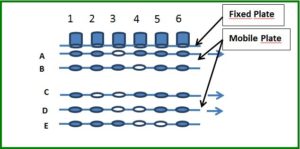
Figure 4– Basic principle of PAS06/15
The figure show a fixed plate where six passive samplers are screwed on. Under this plate, there is a second plate which is mobile, thus able to move in both directions. The mobile plate include a series of six holes. These may be closed with plastic plugs or left open. In the above example, the configuration A show just one open hole which allow the passive sampler 3 to collect pollutant molecules, while the other passive samplers will remain in a non-sampling status. If the mobile plate is moved one step forward, then the configuration B is resulting. This configuration allows sampling on passive sampler 4, while sampler 3, as well as other samplers, is kept closed. According to this scheme, ENVINT PAS06/15 is programmed in order to move one step forward after a given sampling period, then passive samplers can be sampled one after the other.
In configuration C, passive samplers 2 and 3 are active. If the mobile plate is moved forward by one step, the configuration D is reached. Here, active samplers are the numbers 3 and 4 while the sampler 2 is closed, thus not sampling. Another step forward will move the mobile plate in the configuration E where sampling on 2 and 3 is no longer present and sampling on 4 and 5 is active.
This is the way how ENVINT PAS06/15 is operating, i.e., a series of instructions
which properly combines passive samplers with open or plugged holes,
allowing or hinder passive sampling.
The difference between the examples given above and ENVINT PAS06/15 instrument, is in that the fixed and mobile, schematically represented before by linear plates, are replaced by circular plates in which six holes are punched as it is shown in the next figure. Here, the mobile (1) and the fixed plate (2) are shown. (5) is the receptacle containing the reference sensors holder for the identification of position 1, while (3) is a thin felt of inert material used to isolate plugged and sampled passive samplers. In addition, the felt layer allows easy adaption of mobile on fixed plate.
When in operation, ENVINT PAS06/15 first detaches the two plates by a translation of a few millimetres. When the plates are detached, then the mobile plate is rotating to the position required by the programs in execution. Once the rotation is completed, the mobile plate is pushed back against the fixed one. Felt (3) provides a physical separation between the two plates and also a soft layer between them.
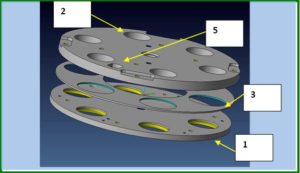
Figure 5– The essential elements of the sampler.
By rotating the mobile plate, different configuration may be obtained. Since the rotation allows up to six different positions, and since from one to 5 plugs can be used in the same plate, the user may take advantage of different combinations useful to finalise his monitoring objectives as it will be shown later on with some practical examples.
The figure below shows how mobile (Red) and fixed plate (Black) are working and how they should be managed in programming the ENVINT 06/15. The coloured small dots identify the position 1. While mobile plate accommodates plugs, the fixed plate contains passive samplers.
In the following examples, and figures:
- Plugs on mobile plate will be represented by reddish filling.
- Passive samplers on the fixed plate are represented by coloured filling.
- Numbers increase clockwise
The first example (configuration A), is shown in the figure below:
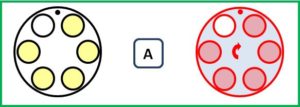
In this simple example, passive samplers are located in the fixed plate in position 1,2,3,4,5, while position 6 is empty. The mobile plate has holes 1,2,3,4,5 plugged while position 6 is left open. If the mobile plate is rotated one step (to position 2) then the hole on mobile plate moves under passive sampler 1 which then start air sampling. After another step, passive sampler 2 will be active and so on. According to this program, we may compile a table in which it is possible to identify the status of the passive samplers according to the rotation of the mobile plate:
(NO stands for not sampling; YES stands for sampling):
Configuration A | |||||
| Position | Passive sampler 1 | Passive sampler 2 | Passive sampler 3 | Passive sampler 4 | Passive sampler 5 |
| 1 | NO | NO | NO | NO | NO |
| 2 | YES | NO | NO | NO | NO |
| 3 | NO | YES | NO | NO | NO |
| 4 | NO | NO | YES | NO | NO |
| 5 | NO | NO | NO | YES | NO |
| 6 | NO | NO | NO | NO | YES |
Configuration A is a simple sequential sampling in which passive sampler 1 starts the sampling at a given time and the other passive samplers are exposed one after the other. When the cycle is over, the sampled devices will stay in a non-sampling statues, waiting for a technician to collect them and, eventually, to substitute them with new ones. In other words, this is nothing else that a simple sequential program.
However, ENVINT PAS 05/16 may be adapted to more complex programs, then to more complex monitoring strategies. An example is given below (Configuration B)
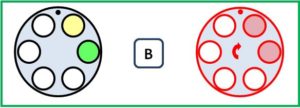
In the configuration B, passive sampler intended for the collection of a specie X (in green filling) and of a species Y (in Yellow filling) are placed in receptacles 1 and 2 of the fixed plate respectively In this configuration (position 1), passive samplers are not sampling since the holes in the mobile plate are plugged. If the mobile unit rotates one step forward (Position 2) then species Y is sampling, while the X is not. On rotation of another step (Position 3) then both passive samplers are sampling.
We may represent the different possibilities by the following table which show position and the relative sampling status of the two passive samplers
Configuration B | ||
| Position | Passive sampler X | Passive sampler Y |
| 1 | NO | NO |
| 2 | YES | NO |
| 3 | YES | YES |
| 4 | YES | YES |
| 5 | YES | YES |
| 6 | NO | YES |
If both passive samplers need to be sampled simultaneously, then the mobile plate should be moved in position 3 or 4 or 5. Position 1 will prevent sampling on both. Position 2 and 6 alternates sampling of X and Y.
Taking into account the above consideration, it is possible to define combinations of passive samplers and plugs in order to satisfy a given more complex strategy. For instance, suppose a simultaneous measurement of Nitrogen Oxides and Ozone during selected intervals of the day (for instance between 10:00 and 17:00 (When Ozone reaches the maximum levels); and the same measurement between 17:00 and 10:00 of the day after (When Ozone reach the minimum values), then configuration C may be adopted..
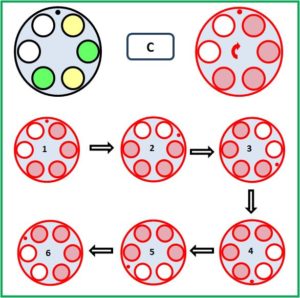
In this configuration, passive samplers in position 1 and 3 are for one species and positions 2 and 4 for the other. The mobile plate has plugs in positions 1,2,3,4. In such configuration, the table would appear as:
| Configuration C | ||||
| Position | Samp. O3/1 | Samp. O3/2 | Samp. NOx/1 | Samp. NOx/2 |
| 1 | N | N | N | N |
| 2 | Y | N | N | N |
| 3 | Y | N | Y | N |
| 4 | N | Y | Y | N |
| 5 | N | Y | N | Y |
| 6 | N | N | N | Y |
Therefore, every day the sampler can move to position 3 from 10:00 to 17:00 to accumulate pollutants on passive samplers O3/1 and NOx/1. Moving the sampler to position 5, accumulation on O3/2 and NOx/2 occurs. After, for instance, one week or ten days of alternate sampling, the sampler is moved again into position 1 where sampling is stopped on all four passive samplers. At this point, the two couple of passive samplers can be collected and analysed to provide the average ozone and nitrogen oxide concentrations between 10:00 and 17:00 and the same values between 17:00 and 10:00.
The following figures shows the details of the sampler.
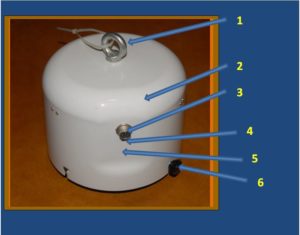
Figure – external view
The external view shows:
- 1 Hook for holding the sampler in vertical position (as it is shown)
- 2 External plastic cover
- 3 Receptacle for external connections (Power supply, Digital Inputs, etc.)
- 4 Sensor for ambient Temperature and Relative Humidity
- 5 Area of Wi-Fi activation (Through magnet)
- 6 Knobs to open the cover
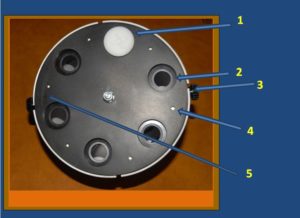
Figure – Bottom view
Bottom view shows the mobile (rotating) plate:
- 1 Plastic plug in a hole (gas diffusion not active)
- 2 Unplugged hole (open to diffusion)
- 3 Knob for cover opening
- 4 Sensors for positioning the mobile plate
- 5 Reference sensor and dot for position numbering
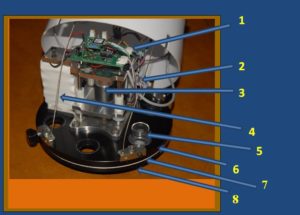
Figure – Internal view of the sampler
- 1 Electronics and internal memory
- 2 Steel wire for holding the sampler to cover
- 3 Actuating motors (translation and rotation)
- 4 Back-up battery
- 5 Passive sampler screwed in the fixed plate
- 6 Fixed plate
- 7 Felt layer
- 8 Mobile Plate
Applications
The combination of ENVINT PAS 06/15 and ANALYST® passive samplers open several possibilities not possible in the past. They are related to planning measurement according to a series of conditions which may related to timing or triggered by external event. The applications which follows are derived by experiences following the use of ANALYST® passive samplers. However, they should be considered example on how ENVINT PAS 06/15 and ANALYST® passive samplers may give a positive answer to several problems related to air quality:
- Sequential sampling in air quality measurement. After the exposure of a passive sampler, a new one can be exposed to air. The sampled passive sampler is maintained in the ENVINT PAS 06/15 without further contact with the external air, so that storage does not affect the analytical response. Field technician do not need to remove passive samplers at a fixed time.
- Preliminary assessment of air pollution when no or little information about air quality in a given site are available.
- Monitoring sites not served by conventional monitoring stations. Several pollutants may be monitored by passive sampling. PAS06/15 may easily replace a monitoring stations for exposure assessment.
- Classification of a site. Monitoring of two or three pollutant may give indication about the nature of the monitoring site (Urban industrial, background, etc.)
- Space integration of air pollution data. Since conventional monitoring stations are limited In number, even a small number of passive sampling sites may give useful information the extend their representativeness.
- Spatial mapping of atmospheric pollution. A number of sampling sites may give some useful representation about the occurrence of pollutants in selected sites. This is for instance the case of industries, incinerators, dumps and landfill sites, etc.).
- Ozone monitoring by selecting a sample for the central part of the day and another passive sampler for the other periods of the day. Pollutant accumulated in the first or second samplers may give information about the distribution of ozone along an average period of sampling (e.g., from 1 week to one month).
- Exposure monitoring: activation of ENVINT PAS06/15 according to the presence or absence of people. This is the case for schools, working sites etc.
- Sampling on events. This means that passive samplers are selected according to events which are sensed by ENVINT PAS06/15 as external logical conditions. Up to eight conditions may be programmed in combination with the basic time programming.
- Sick building syndrome will be easily characterised by programming passive samplers during building use or under specific conditions (temperature, humidity, etc.)
- Public transportation: the sampler can be programmed in order to discriminate exposure during effective use of the vehicles for people transportation.
- Traffic pollution. Monitoring may be started or planned according to specific traffic conditions in order to, for instance, monitor exposure as a function of average traffic velocity and/or density
- Recording other environmental parameters. By default, ENVINT PAS06/15 is able to record data on temperature and relative humidity. These data are stored into the internal memory and can be downloaded through a Wi.Fi connection.
- Other analog parameters may be input as options, recorder and stored in the memory of the device. In this way ENVINT PAS06/15 becomes a real monitoring stations with an appropriate data acquisition system.
Relevant Technical Publications
- Wang, F., Costabile, F., Liu, F., Hong, W., Fang, D., & Allegrini, I.. Ambient BTX measurements in Suzhou, China. Environmental monitoring and assessment, 168(1-4), 21-3,. (2010)
- Costabile, F., Bertoni, G., De Santis, F., Bellagotti, R., Ciuchini, C., Vichi, F., & Allegrini, I. Spatial Distribution of Urban Air Pollution in Lanzhou, China.Open Environmental Pollution & Toxicology Journal, 2. (2010).
- Salzano, R., Vichi, F., Allegrini, I., Salvatori, R., De Santis, F. Use of diffusive sampling for the evaluation of the impact of a power plant located at Termoli (Italy). In Proceedings of the Measuring air pollutants by diffusive sampling and other low cost monitoring techniques. 15-17 September 2009, Krakow (Pl). Book of abstract, pp. 27, (2009)
- De Santis F., Allegrini I., Bellagotti R., Vichi F., Zona D. “Development and field evaluation of a new passive sampler for hydrogen sulphide in the ambient air” Anal. Chem.; volume: 384(4), 897-901 (2006).
- Costabile F., Bertoni G., De Santis F., Wang F., Hong W., Liu F., Allegrini I. “A preliminary assessment of major air pollutants in the city of Suzhou, China.”. Atmospheric Environment; volume: 40, N.33; 6380-6395. (2006)
- Costabile, F., Wang, F., Qin, X., Hong, W., Liu, F., Yin, Z., & Allegrini, I. (2005). “Application of a new approach for monitoring atmospheric pollution in a Chinese city:-Suzhou”. Huazhong Architecture
- De Santis F., Fino A., Menichelli S., Vazzana C., Allegrini I., “”Monitoring the air quality around an oil refinery through the use of diffusive sampling.””, Analytical and Bioanalytical Chemistry; volume: 378, N. 3; pp. 782-788. (2004)
- De Santis F, Zona D, Bellagotti R, Vichi F, Allegrini I., “”Ozone monitoring in a Mediterranean forest using diffusive and continuous sampling.””, Analytical and Bioanalytical Chemistry; volume: 380, N. 5/6; ; pp. 818-823. (2004)
- De Santis F., Vazzana C., Menichelli S., Allegrini I., “”The measurement of atmospheric pollutants by passive sampling at the Uffizi Gallery, Florence.””, Annali di Chimica, volume 93, N.1-2, Jan-Feb, pp 45-53. (2003)
- Manes F., De Santis F., Giannini M.A., Vazzana C., Capogna F., Allegrini I., “Integrated ambient ozone evaluation by passive samplers and clover biomonitoring mini-stations” Science of Total ENvironment 308(1-3) 133-141 (2003).
- De Santis F., Dogeroglu T., Menichelli S., Vazzana C., Allegrini I., “”Laboratory development and field evaluation of a new diffusive sampler to collect nitrogen oxides in the ambient air.””, Analytical and Bioanalytical Chem; volume 373 pp 901-907. (2002)
- Fino A., Menichelli S., Vazzana C., Allegrini I. “Laboratory development and field evaluation of a new diffusive sampler to collect nitrogen oxides in the ambient air” Anal. And Bioanal. Chem. 373(8), 901-907 (2002)
- Allegrini I., Costabile F.,”A new approach for monitoring atmospheric pollution in urban environment” ,”Proceeding of the international seminar urban air quality management 21-22 oct 2002.
- De Santis F., Vazzana C., D’Angelo B, Dogeroglu T., Menichelli S., Allegrini I., “Validation and use of a new diffusive sampler for ozone assessment in the Lazio Region, Italy”,2002,”Advances in air pollution series, WIT press, 11, 371-380 (2002).
- De Santis F., Vazzana C., Menichelli S., Allegrini I.,”The measurement of atmospheric pollutants by passive sampling at the Uffizi Gallery, Florence.”,Annali di chimica 93 (1-2), 45-53 (2002).
- De Santis F., Fino A., Vazzana C., Allegrini I., “”Monitoring of atmospheric pollutants by passive sampling for the protection of historic buildings and monuments.””, Annali di Chimica, volume.91, N. 11-12, pp. 759-765. (2001)
- Bertoni G., Tappa R., Allegrini I.,”The internal consistency of the ‘analyst’ diffusive sampler—A long-term field test”, Chromatographia, 54, 653-657 (2001).
- De Santis F., Dogerolu T., Menichelli S., Vazzana C., Allegrini I.,”The use of a new passive sampler for ozone and nitrogen oxides monitoring in ecological effects research”,The Scientific World Journal 1, 475-482 (2001).
- Allegrini I., Bertoni G., Tappa R., “”Assessment of a new passive device for the monitoring of benzene and other volatile aromatic compounds in the atmosphere.””, Annali di Chimica, Vol.90, N.3-4, pp. 249-263. (2000)
- De Santis, F., Fino, A., Tiwari, S., Vazzana, C., & Allegrini, I. “A performance evaluation of the open tube diffusion sampler (Palmes sampler) for monitoring nitrogen dioxide” International conference on air pollution, No8, Cambridge , UK pp. 421-429. (2000).

